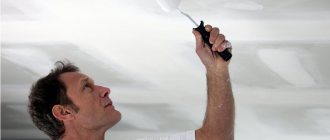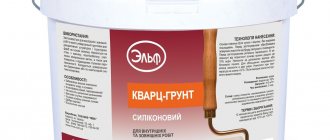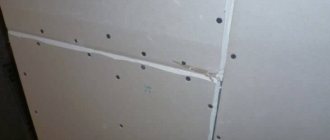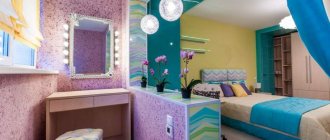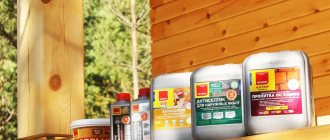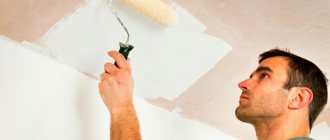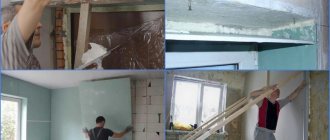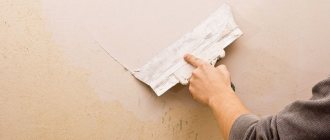→ Materials
Preparing the plasterboard surface for finishing includes several stages - sealing the seams, coating with putty and primer. One of the important layers that performs several functions is the primer:
- a kind of waterproofing film appears on the surface of the drywall;
- increases the adhesive qualities of the plasterboard surface;
- strengthens the top layer, penetrating deep into the material, where the composition polymerizes and becomes durable.
That is, for gypsum board sheets this is a very important component, which before finishing the material will make it durable and reliable with a long service life.
What are primers used for?
The primer plays an important role in the finishing process. But, unfortunately, many do not understand this and, which is very dangerous, skip this stage. And then they wonder why the putty comes off, the plaster falls, or the paint peels off.
Everything is very simple. The process of applying primers is part of a single technological chain of finishing works and this step should not be skipped under any circumstances.
Which drywall primer to choose can be decided after reading this article.
Additionally, you can watch video clips on our website.
Let's look at what primers there are and what they are needed for.
All primer compositions are divided into the following types:
- water-repellent;
- deep penetration;
- adhesive;
- antiseptic;
- fire protection
All these characteristics are not at all mutually exclusive. Several properties can be combined in one composition.
Preparing the mixture
Sealing the seams at the next stage involves preparing putty. Pour a certain amount of dry composition into a bucket, fill it with water using a construction mixer and stir until smooth. There should be no lumps in it. The mass should not drain from the spatula.
Compositions for working with drywall
Betokontakt
Let's start with the fact that GVL sheets can be glued to flat walls in a frameless manner. In this case, it is necessary to first prime the wall surface using special adhesive primers.
This could be, for example, “Betokontakt from German manufacturers or our “Beton-kontakt”.
Betokontakt 20 kg (special adhesive primer).
Applying such a primer to the wall increases the adhesion of the surface under the gypsum adhesive on which the gypsum board will be glued.
Can also be used for processing cladding made of KNAUF sheets.
The application process occurs in three stages:
- wall surface preparation;
- preparing the solution (preparation instructions are on each package);
- applying primer using a roller or brush.
Betocontact consumption is approximately 0.350 kg/m2, you can work at a room temperature of at least 5 degrees. The price for betocontact is slightly higher than for a regular primer that does not have its properties. But this is the case when it is not worth saving - the result is more expensive.
Deep penetration primer
Penetrating adhesive primer for gypsum plasterboards.
The Knauf sheets themselves are primed with a penetrating compound, which must also have adhesive properties.
When deciding which primer to choose for drywall, you need to understand that such a composition must be capable of deep impregnation and strengthening of the surface made of gypsum board.
What primer is best for drywall? One that is capable of several times increasing the adhesion between materials, characterized by high technical and quality indicators, and characterized by ease of work with it.
Its main properties should be the following:
- high penetrating ability;
- improves adhesion;
- binds dust;
- resistant to chemical influences;
- non-toxic, absolutely safe for health;
- ensures subsequent uniform coloring;
- reduces the consumption of wallpaper glue and paint;
- dries quickly;
- moisture resistant;
- heat resistant.
A high-quality primer composition for GVL strengthens it, significantly reducing the degree of water absorption.
This composition should protect the sheets from the effects of microflora:
GCR, which is impregnated with layers of special soil, serves for many years without losing its appearance and properties. The putty lies more evenly on the primer, since the latter improves the adhesion of various finishing materials.
Methods for applying drywall primer
The primer is applied to drywall with a brush or roller. Sometimes, when treating very large surfaces, a sprayer is used.
Before starting work, it is advisable to clean the surface to be treated.
The surface is primed several times depending on the finishing stages:
- it is necessary to very carefully prime all seams, joints and places where screws are attached before applying leveling putty to them;
- the entire surface of the drywall is primed after sealing the joints and corners with putty before further finishing;
- The surface of the puttyed drywall is primed before the stage of painting or wallpapering.
The photo shows the process of rolling out primer from a special cuvette.
Advice. It is most convenient to pour the primer into a special trough and, when putting it on a roller, you need to squeeze the roller enough so as not to spill the composition on the floor.
Primer selection
Further questions arise, which primer for drywall is better, which primer to choose from the huge variety of offers on the market?
When choosing, pay attention to:
- price;
- manufacturer's company;
- best before date.
Important: For drywall, you can use the composition only for interior work; you cannot use it for façade work. The fact is that the façade primer contains substances prohibited for use in residential premises.
Surface preparation
Before applying the primer, the drywall sheets are pre-treated.
Preparation consists of the following steps:
- Trimming chamfers, sanding irregularities.
- Checking the position of the fastening screws. Their heads should not protrude above the surface
- Clean the surface from dust with a dampened soft cloth or a brush that does not lose bristles.
- Securing the seams with reinforcing mesh.
The mesh is secured to the seams with gypsum putty. It is applied in an even, thin layer, then the sickle is drowned in it. You need to cover the heads of the screws with putty.
Conclusion
As you already understand, the process of priming drywall surfaces before each stage of finishing work is necessary and without it we can simply ruin the result.
If we are lazy or decide to simply skip this stage in order to save money, we will end up with defects, namely peeling wallpaper or peeling paint.
When making structures from plasterboard with your own hands and then finishing them, do not forget about the need to prime the surfaces.
If you strictly follow the technological work cycles, you are guaranteed an excellent result.
How to prime drywall
The finishing of drywall is carried out on a previously leveled and primed surface. Not everyone understands the advisability of applying primer. That's why they skip this stage of repair, trying to save a little money on it. And then they wonder why their wallpaper is falling off or their plaster decor is falling off.
There is nothing surprising, because the integrity of the technology was violated during finishing. Many finishing procedures on gypsum plasterboard cannot be done without priming. And those who skip it will inevitably face the problems outlined above.
What is the result of priming plasterboard sheets when finishing them, which primer for plasterboard is most suitable. The answers exist, they are given in the information below.
What is this article about?
Justification of the feasibility of using soil for HA
Professional builders name several arguing factors in favor of using soil on gypsum fiber boards. In particular, these reasons are considered:
- Subsequent paint consumption will be much more economical, since the pores of the paint will be filled with soil.
- The functions of primers are varied. Due to this, gypsum board is given the properties of fire safety, bactericidal properties, and durability.
- After applying primer, plasterboard walls become noticeably smoother.
The range of primers is quite extensive. It varies in manufacturer, cost, composition of primers and their functions. However, you should not choose primers for drywall based only on the price factor. Since they are all quite inexpensive, you won’t be able to save much. But it’s worth paying attention to the specifics and brand.
Variety of primers
The choice of commercially available primers is based on their basic properties. Moreover, there may be several such properties. In this connection, all coatings are usually divided into groups:
- adhesive;
- deep absorption;
- moisture resistant;
- fire resistant;
- with bactericidal properties
A description of each group is given below.
Drywall owes its adhesive properties to the primer by significantly increasing the density of its structure and minimizing the size and number of pores. For this material, adhesion is very important. There is no need to neglect priming before painting with HA, plastering, or wallpapering. The best option would be to use universal formulations for different types of HA (like Colorit or Knauf). In addition, as a result of their use, lint, dust particles, and other contaminants are washed out of microcracks. The result of reducing the porosity of the plasterboard structure due to the use of primers is an increase in the service life of the slabs.
The moisture-resistant primer, accordingly, allows the wall materials not to absorb moisture. It is an excellent option for renovations carried out in the kitchen and bathroom. That is, in areas of the apartment with a high moisture-resistant regime. In addition, she is used for outdoor work.
The fire-resistant composition of primers is suitable for preparatory work on surfaces for paint or putty in a timber or wooden house. As a result of the presence of liquid rubber additives, the coating gives the HA a dense structure, improving its physical properties. Thanks to the fire resistance of the coating, the fire of the walls can be stopped.
Moisture-resistant compositions with antiseptics determine their area of application in homes located in regions with critical weather humidity conditions. Gypsum in such mixtures acts as a natural antiseptic. It creates a barrier against the appearance of condensation moisture and mold on the plasterboard ceiling and walls. This option is also chosen when choosing a covering for corridor walls, kitchen walls, or those located in the bathroom, on the staircase, or on the facade of the building.
Finding the Ideal Primer
The cost factor, service life, and brand play an important role when choosing a suitable primer for HA. It is clear that it is better to choose a well-known manufacturer in this field than a not so well-known one. This will allow you to make no mistakes with the quality and performance of the mixture. Interior finishing products are intended for plasterboard work. Because primers designed for streets contain a threshold level of toxins. The presence of the latter is unacceptable in an apartment or house. Acrylic primer is considered ideal for many materials (we will talk about it later).
When choosing soil, you need to understand what kind of coating it is intended for. For example, some technologies provide for the presence of a primer layer under the putty. Therefore, if you have to putty drywall, then you need to look for a composition with an eloquent indication on the label “for special purposes.”
Pasting walls with thin paper wallpaper strips does not place excessive demands on the soil. Therefore, products that do not penetrate deeply into the structure of materials are suitable here. However, in a situation with heavy vinyl or non-woven wallpaper, it is advisable to put a little more effort into selecting a suitable soil. And it is better if it is characterized by a deep degree of penetration.
In addition, a primer is also required for drywall before tiling the latter. Here we should pay tribute to the moisture-resistant mixture.
Classification of primer mixtures by composition
The unique composition of each primer allows it to be classified as follows:
- acrylic;
- phenolic;
- alkyd;
- polystyrene;
- perchlorovinyl.
As noted above, the best option for priming plasterboard structures is an acrylic composition. It is unique and has a whole range of useful properties.
In addition to GVL, acrylic mixtures are suitable for various types of surfaces (for example, brick). They dry out quickly. If for other compositions the waiting period for drying takes about a day (at a temperature of +20 degrees), then the acrylic primer dries in about 6 hours. Acrylic primer will be appropriate not only as a layer under putty, but also as a final layer after it. The acrylic mixture has a light shade. Often it is simply white, which can be very convenient when applying a finishing layer of putty to GC walls.
All other compositions do not exclude the presence of toxic substances in their structure that are detrimental to human health. Therefore, they are prohibited for indoor use in living rooms. Whereas for utility rooms they are quite suitable. In addition, their antiseptic index is at a high level. However, for an apartment this is not so critical.
In particular, it is permissible to use perchloride composition during the procedure of pasting building facades with thermal panels. The toxicity of the described compounds obliges every person interacting with them to wear respirators to protect the upper respiratory tract.
Knowing that priming HA sheets is mandatory in finishing, it would be necessary to understand in more detail what priming plasterboard is considered more reliable.
The nuances of using Betokontakt primer
It is worth noting that plasterboard sheets can be fixed to a frameless wall surface. In such a situation, the ceiling or wall space is first primed with special adhesive compounds. Why do they attract either our domestic Beton-Kontakt, or a foreign one - German-made BetoKontakt?
Priming the wall with such means ensures the adhesiveness of the surface materials with the glue through which the sheets will be attached. They can process cladding made from KNAUF panels.
The three-step work procedure includes:
- surface preparation;
- administering the solution according to the instructions on the packaging of the product;
- spreading the soil with a brush or roller.
Betokontakt is consumed in a ratio of 0.35 kg per 1m2. Work with his participation in the room is carried out if the temperature there does not fall below 5 degrees.
GVL, the finishing or installation of which was carried out with the obligatory priming of the surfaces, will last longer without losing its qualities and aesthetic properties. So is it worth saving on purchasing primers for HA?
There are no specific rules for applying primer to drywall. The most important thing is to completely cover the surface to be treated. In some cases, two layers are applied. For example, in damp areas.
This is simply done to calm the soul. After all, a good primer applied in one layer is a high guarantee. Available in buckets of 5 and 10 kg. Consumption per square meter – 70-100 g. Primer for drywall “Betokontakt is used if the drywall surface will be finished with ceramic tiles. The temperature at which you can work with this species is 5-25 degrees Celsius.
What primer to prime drywall
Available in buckets of 5 and 10 kg. Consumption per square meter – 70-100 g. Primer for drywall “Betokontakt is used if the drywall surface will be finished with ceramic tiles. The temperature at which you can work with this type is 5-25 degrees Celsius. I think everyone knows that before further finishing of surfaces, plasterboard or not, it should be primed. Why do this, waste money, time, make efforts, because the effect seems to be completely unnoticeable?
Primer coating strengthens and improves the adhesion of finishing materials. That is, you will be able to avoid situations of uneven application of paint to putty or peeling of plaster. Both components of drywall are hygroscopic. Without special additives, gypsum plasterboard absorbs even water molecules floating in the air, swells and collapses.
To protect against dampness, reduce paint and glue consumption, and create a uniform coating, a drywall primer is used. A large selection of compositions for various conditions is manufactured by Knauf. You can make your own mixture using PVA glue.
- a kind of waterproofing film appears on the surface of the drywall;
- increases the adhesive qualities of the plasterboard surface;
- strengthens the top layer, penetrating deep into the material, where the composition polymerizes and becomes durable.
The building materials market today offers different primers that are used for different purposes. Here are the main types:
Is it necessary to prime the gypsum board before puttingtying?
Relying only on the arguments of supporters and opponents of priming drywall before puttying, it is impossible to draw clear conclusions in favor of one of the parties. In practice, there are situations when a primer must be used without fail, and there are situations when it is not necessary.
When to
To understand why a gypsum board primer is needed for putty, let’s figure out what a primer is and why it is used.
A primer is a construction mixture applied as the first layer to the surface of walls or ceilings of any material to create reliable adhesion between them and the applied cement (gypsum, cement-gypsum, lime, etc.) mortar or glue, as well as leveling the absorbency of the base .
Not all priming functions are listed in the above definition. There are much more of them:
- adhesion between materials increases;
- the consumption of materials applied to the ground (putty, glue, paint) is reduced;
- the process of applying putty, adhesive and coloring compounds is simplified (the surface is smoother);
- The surface of the wall or ceiling material is strengthened.
In relation to plasterboard, the listed functions are important when finishing walls with wallpaper (later, during repairs, you can remove the wallpaper from plasterboard without any problems, without damaging the cardboard) and ceramic tiles (the surface of the plasterboard will withstand the load and will not collapse).
It is necessary to prime drywall under putty and when applying decorative plaster. Here, the absence of a waterproof film (created by a primer) on the plasterboard leads to a disruption of the hydration process (gypsum actively absorbs water). And this means a reduction in durability, at best, and cracking or peeling of the plaster, at worst.
When not
There are not many situations in life when you don’t need to prime drywall before puttingty.
1. In rooms with high humidity, moisture-resistant plasterboard is used for walls and ceilings (designated as GKLV, color green). Him:
- both the cardboard frame and the gypsum core are treated with waterproofing agents, which minimizes the material's ability to absorb water;
- increased strength;
- Antiseptic agents have been added to the composition, inhibiting the growth and reproduction of mold and bacteria.
In principle, such gypsum plasterboard cannot be primed for one simple reason: the water-dispersion primer will roll off the surface of the walls and hang on the ceiling in drops, since the material has waterproofing. It is impossible to treat with other types of primer that do not contain water due to the high toxicity of the primer.
2. Painting requires perfectly smooth walls , which can only be achieved by applying finishing (very finely ground) putty (the presence of tiny particles of gypsum and polymers allows you to get a perfectly smooth surface, which cannot be done with starting putty).
If the surface of the drywall is primed, you will have to putty it 2-3 times, since the finishing putty is not laid on the ground (it cannot be applied to a poorly absorbent surface). If priming is skipped, then it is enough to apply the finishing primer once. The quality and durability of the painting will not be affected, and the cost and time savings are significant.
Attention: the seam and the fastening points of the screws are always primed (it is advisable to paint the heads of the hardware in advance with oil paint to prevent rust from breaking through), after which starting putty is applied to them. After this, the entire sheet can be coated with a finishing putty composition.
3. Do not prime drywall even if you plan to replace “dry” plaster with “wet” plaster in the near future (5-7 years) .
Why and how to prime drywall
Now let's look at what primer to use on drywall. To do this, you need to decide on the basic requirements for the composition. It must be said that we have considered the most complex procedure for preparing the surface - for painting.
If wallpaper or ceramic tiles are used as a finishing material, then finishing putty may not be performed. Water-based acrylic primers usually have all of the above properties. These compositions are a dispersion of acrylic copolymers with various additives. An important feature of this material, in addition to being environmentally friendly, is vapor permeability, so the coating does not interfere with the natural exchange of vapor in the room. Priming is an important process when performing any finishing work, including drywall.
However, many novice craftsmen skip this stage of work, as a result of which they later encounter problems such as peeling putty, peeling paint, etc. Many people, when starting a serious renovation of their home for the first time, are interested in whether it is possible to prime drywall? As you know, this material does not tolerate moisture, which is what caused this question .
Choosing the right material
When the question arises of what primer to use on drywall, you need to decide what types of this material exist. It is important to choose a material based on the manufacturer, but you still need to know about its existing varieties. The main types are as follows:
- universal acrylic primer is used in most cases, as it is well suited for most surfaces;
- perchlorovinyl solution is also classified as universal, but due to its composition it is not recommended for use indoors. It is ideal for outdoor use;
- Toxic polystyrene materials are also used for exterior work. They help save money, but are practically not used when working with plasterboard;
- the most effective mixture for treating external walls is graphite primer;
- alkyd and phenolic primers are used for treating wooden structures. The latter is also good for metal.
As you can see, from all the variety, only one primer for gypsum board can be chosen - acrylic. However, this is not enough for us, because under the wallpaper in the bedroom and under the tiles in the bathroom we need to use various acrylic primers. Typically, the manufacturer indicates that its products are best suited for wallpaper or painting or other finishing coating.
There are many manufacturers of acrylic primers
When choosing soil, you need to pay attention to its color. It is usually a white or colorless liquid that may change color after drying. Therefore, before priming drywall, you need to find out what the finishing coat will be. Under tiles, the color of the primer does not matter, but under light wallpaper it can be critical.
If it is not critical what color the solution will be, then it is better to choose a noticeable shade. A beginner in the application process needs to see which areas have already been treated and which need additional treatment.
The subtleties of applying primer to drywall before puttying
Also, do not prime drywall if you are going to apply finishing putty to it. It is very elastic and has a high degree of stickiness, and it is simply impossible to apply it to a moisture-repellent primer in a sufficiently thick layer, which makes subsequent sanding difficult.
- Evens out the absorbing properties of the base over the entire surface area. This way, when applying paint or putty, the layer will be more uniform.
- Penetrates deep into the porous base, which helps when working with joints.
- Prevents materials from sticking together into lumps when applied to the surface.
- After drying, it does not interact with water, which is especially important if water-based paint is used after priming.
The process of priming the ceiling is practically no different from what you do with the walls. Before treatment, the surface of the ceiling must also be thoroughly cleaned from the remnants of previous coatings. Unless, for convenience, it is worth lengthening the handle of the roller so that you can easily carry out the work without using a stepladder.
Naturally, all corners and protrusions on the ceiling are thoroughly primed. Please note that the primer does not actually cover the walls with a film, blocking the circulation of oxygen; its structure is more like a mesh around the base. The putty cannot be applied until the primer layer has dried; this is very important. Don't rush to do everything as quickly as possible; rushing here will only harm the process.
Typically, the primer takes about 8 hours to completely dry, after which the surface is puttied.
Step-by-step priming technology
The process of priming drywall is not complicated. It can be easily accommodated in a few simple steps.
- We are preparing the tools. You will need a roller, a telescopic stick, a brush and a special bowl.
- Drywall primer is poured into a bowl. The roller is dipped into it, and the excess flows back into the bowl. It is best to use a white primer so that it matches the shade of the putty.
- For faster work, the roller is put on a telescopic stick so that you can reach it from the floor everywhere.
- The material is applied evenly over the entire surface. It is important that there are no leaks. To do this, remove excess material from the roller while still in the bowl. If smudges appear, they must be removed immediately. Otherwise, in these places the surface may change its color.
- All areas that are difficult to reach with a roller are carefully treated with a brush. Usually these are corners, joints, the inside of the window opening, junctions with the floor and molding, etc.
- Cutting joints need to be handled especially carefully. You should also treat chips, deep scratches and abrasions if they accidentally appear on the gypsum board.
Absolutely everything that will interact with the future coating needs to be primed.
Primer for drywall for wallpaper, painting and tiles
- After treatment with this material, the pores of the drywall are compacted, which can significantly reduce the consumption of paint and glue;
- The soil mixture has many positive qualities. Depending on the composition, it can protect against fungi, prevent fire, increase the service life of walls and partitions;
- The surface of the sheets is noticeably leveled after applying the mixture. It helps eliminate small depressions.
Adhesion is an increase in surface density, a decrease in pores in drywall. A very useful quality for this building material. In particular, such soil mixtures are necessary before painting or wallpapering. They help not only to wash dust and dirt out of microscopic cracks, but also to reduce their size and, as a result, significantly increase the service life of gypsum board. Photo - applying primer to drywall
- Depending on the type of primer chosen, you need to wait until the surface is completely dry. Experts recommend waiting at least 24 hours regardless of the type - this will allow all components to penetrate deep into the drywall;
- Afterwards, another layer of primer is applied to consolidate the result. It also takes 1 day to dry. Next, you can begin finishing processing.
- metal painting;
- concrete plaster;
- wood varnishing;
- surface treatment before puttying;
- applying finishing materials to old surfaces.
For the repair process, it is very important to choose a primer that is suitable for a specific type of work. There are many types of this building material, which vary in their qualities, composition and cost. The first step is to clean the wall of dust and dirt. To do this, take a slightly damp cloth and wipe the surface. If necessary, repeat the process several times. This will allow the primer to penetrate deeper into the pores and eliminate unevenness. After this, you need to wait for the drywall to dry completely. On average, at normal room temperature it will take 2 hours. If the drywall is impregnated with primer, to achieve the required thickness of the finishing coating, you will have to apply 2-3 layers of putty, when one pass on an unprimed surface with good skill is enough. Betocontact consumption is approximately 0.350 kg/m2, you can work at a room temperature of at least 5 degrees. The price for betocontact is slightly higher than for a regular primer that does not have its properties. But this is the case when it is not worth saving - the result is more expensive. Cheap and high quality can only happen in an alternative reality, where mutually exclusive phenomena can calmly coexist.
What is the best primer for drywall? This question can be answered unambiguously. Acrylic, deep penetration, from well-known manufacturers.
Which is better: heated floors or radiators?
Warm floorBatteries
As for drywall, this is exactly the case when “you can’t spoil the porridge with oil.” All those properties that a high-quality, general construction primer has when processing gypsum plasterboard will be used and will most favorably affect the quality of subsequent finishing work. During renovations, you want to save as much as possible and not spend money on unnecessary materials. Is it possible to refuse to use primer without fear for the finished coating?
This question must be answered depending on what kind of finishing coating will be used. To understand in what cases a primer is not necessary to use, you need to understand why it is needed at all. What positive qualities does this material have? It is worth paying attention to the consumption of primer on drywall per 1m2. This indicator is always indicated by the manufacturer on the packaging. You should always add about 10% to it to get a real result. It should also be taken into account that the consumption is indicated for one layer, but you will need to apply the primer in two layers (the second is applied after the first has completely dried).
Consumption usually ranges from 100-150 grams per square meter.
How to treat the surface → Room decoration → How to choose the right paint → Surface treatment technologies → Leveling and finishing the walls → Selecting and applying a primer → Removal from the surface → Stretch ceilings and technologies → Reviews and testimonials
Theory
First, a few general comments. Finishing walls and ceilings with plasterboard can in one way or another be associated with several types of basic or related work:
- GKL sticker on gypsum glue when leveling walls with differences or blockages of moderate size (up to 50 mm);
- Puttying seams, recesses from fasteners and (sometimes) the entire surface of the plasterboard finish;
- Sanding after puttying;
- Painting;
Painting plasterboard walls.
- Wallpaper sticker;
- Laying tiles in the bathroom, toilet and kitchen.
When puttying or gluing (both drywall on a mineral base and any other finishing material on drywall), the surfaces involved must satisfy a number of conditions:
- Don't crumble. The easiest way to check compliance with this requirement is by running a damp hand over the surface: there should be no marks left on the palm;
- Be durable, without delamination and peeling coatings;
GKL cannot be glued to a wall with peeling plaster.
- Have moderate absorbency. Both excessively intense absorption and its complete absence are equally harmful. In the first case, the consumption of glue and paint will increase unjustifiably, or the strength of the finish will decrease due to the absorption of the binder by the surface. In the second case, a smooth surface simply will not provide sufficiently reliable adhesion to the adjacent finishing layer.
The adhesion strength of any finish to the base is directly proportional to the area of contact with it. A rough base has a surface area many times greater than a smooth base.
The rough absorbent base has maximum adhesive properties.


